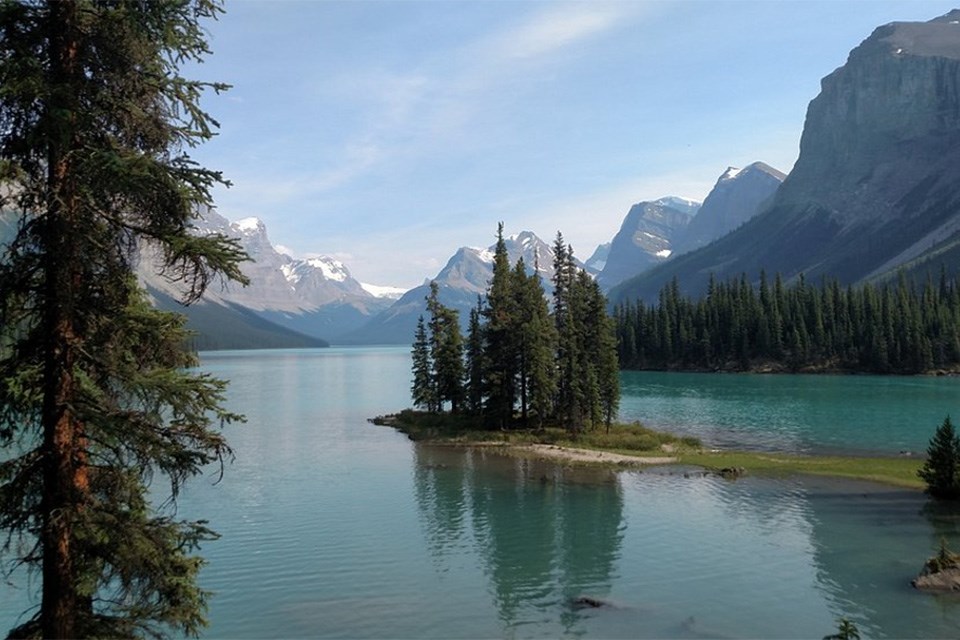In Jasper National Park, Spirit Island is a place of almost mythical allure. Renowned for its serene setting, it remains one of the most photographed locations in the Canadian Rockies – and for good reason. Its charm, combined with its iconic geography, has captured the imaginations of travellers, movie makers, and photographers the world over. Whether you're looking to explore its history, understand its significance, or simply want to know how to capture the perfect photograph, Spirit Island promises something special for every visitor.
What is Spirit Island?
Spirit Island is a small but iconic island located within Maligne Lake, a vast glacial beauty stretching over 22 kilometers. Despite its modest size, this island stands out against a backdrop of towering mountains, turquoise-blue waters, and lush evergreen trees. The "island" is more accurately termed a peninsula, as it’s connected to the shore by a strip of land during low water levels. Yet, its isolated feel and striking positioning make it the centerpiece of many bucket-list adventures. It's protected as part of Jasper National Park, preserving its pristine state and ensuring that future generations will also experience its natural beauty.
Where is Spirit Island Located?
Spirit Island lies deep within Maligne Lake, which is itself located in Jasper National Park – part of the Canadian Rockies and a designated UNESCO World Heritage Site. The park spans over 11,000 square kilometers and is known for its abundant wildlife, dramatic peaks, and awe-inspiring vistas.
To reach Spirit Island, visitors travel to Jasper, and from there, head to Maligne Lake. Because the island is only accessible by boat, visitors typically book guided tours or rent kayaks and canoes. The location is remote, adding to the adventure and sense of discovery. Guided cruises departing from the Maligne Lake Boathouse provide a convenient and comfortable way to reach the island.
A Glimpse into Spirit Island's History
Spirit Island holds deep cultural and spiritual importance, particularly for the Indigenous peoples of the region. For the Stoney Nakoda First Nations, the island and its surroundings were deeply sacred, tied to stories of connection with nature and ancestral significance. One account tells of how Spirit Island became a place of retreat, reflection, and renewal, offering solace to those who visited.
The modern fame of Spirit Island began to rise in the mid-20th century when photographer Peter Gales captured its image. His photograph, displayed in Kodak's Colorama exhibit in New York’s Grand Central Terminal, introduced Spirit Island to a global audience, solidifying it as one of Canada’s most revered landmarks.
The Unique Factors that Define Spirit Island
There are numerous reasons why Spirit Island stands apart from other natural landmarks.
First, its inaccessibility makes it feel like a world apart. With no roads leading to it, the island can only be visited via boat or paddle, preserving its peaceful atmosphere.
Second, the interplay of elements around Spirit Island is nothing short of magical. The vivid blue of Maligne Lake – caused by sediment from nearby glaciers – contrasts vividly with the greenery of the island’s trees and the stark grays and whites of the surrounding rocky peaks.
Finally, Spirit Island’s unique placement within Maligne Lake gives it a surreal quality. Often photographed from a viewing dock with mountains rising behind it, the island appears perfectly framed, as though nature designed it for a photographer’s lens.
Photography Tips for Capturing Spirit Island
Photographing Spirit Island can feel both exciting and daunting – its natural beauty is so iconic that capturing it authentically becomes a worthy challenge! Here are some tips for those hoping to create photos that shine.
Book the Right Time: Lighting plays a crucial role in photography, and the same holds true for Spirit Island. Early morning and late afternoon trips often provide softer, more flattering light for photos, reducing harsh shadows.
Use the Viewing Platform: The provided dock near Spirit Island is purposefully situated to give the best perspective. It’s the classic shot featured in many famous images of the island.
Bring the Right Gear: A tripod is helpful for capturing stable, high-quality images, especially under varying light conditions. Wide-angle lenses, too, can help to include more of the surrounding scenery in your frame.
Mind the Weather: The weather in the Canadian Rockies can change suddenly. Plan your visit around forecasts, but also be ready to adapt – moody skies can add drama and depth to your photographs.
Prioritize the Journey: While the island is the primary focus, remember to soak in the beauty surrounding Maligne Lake. Along the way, you’ll encounter countless opportunities to photograph wildlife, forests, and distant mountain ranges.
Discover Spirit Island for Yourself
Beyond its fame as an image on postcards, Spirit Island is an experience. Visiting this destination is about connecting with nature, appreciating the cultural stories tied to the land, and witnessing the enduring beauty of the Canadian Rockies.
Whether you're an avid photographer, nature lover, or simply seeking a place to slow down and reflect, Spirit Island offers a rare opportunity to step into a world that feels truly timeless.
Don’t wait! Plan your visit to Maligne Lake’s Spirit Island and discover why it continues to captivate hearts and minds across the globe.
Nerissa McNaughton is a freelance writer and a contributor to Great West Media. This story was written for Great West Media's Hot Summer Guide advertising feature. The Hot Summer Guide is a special feature about summer activities, bucket list adventures, staycation options, road trips, attractions, events, and road trip-worthy food & beverage destinations across Alberta. It is not written by and does not necessarily reflect the views of the editorial staff.



